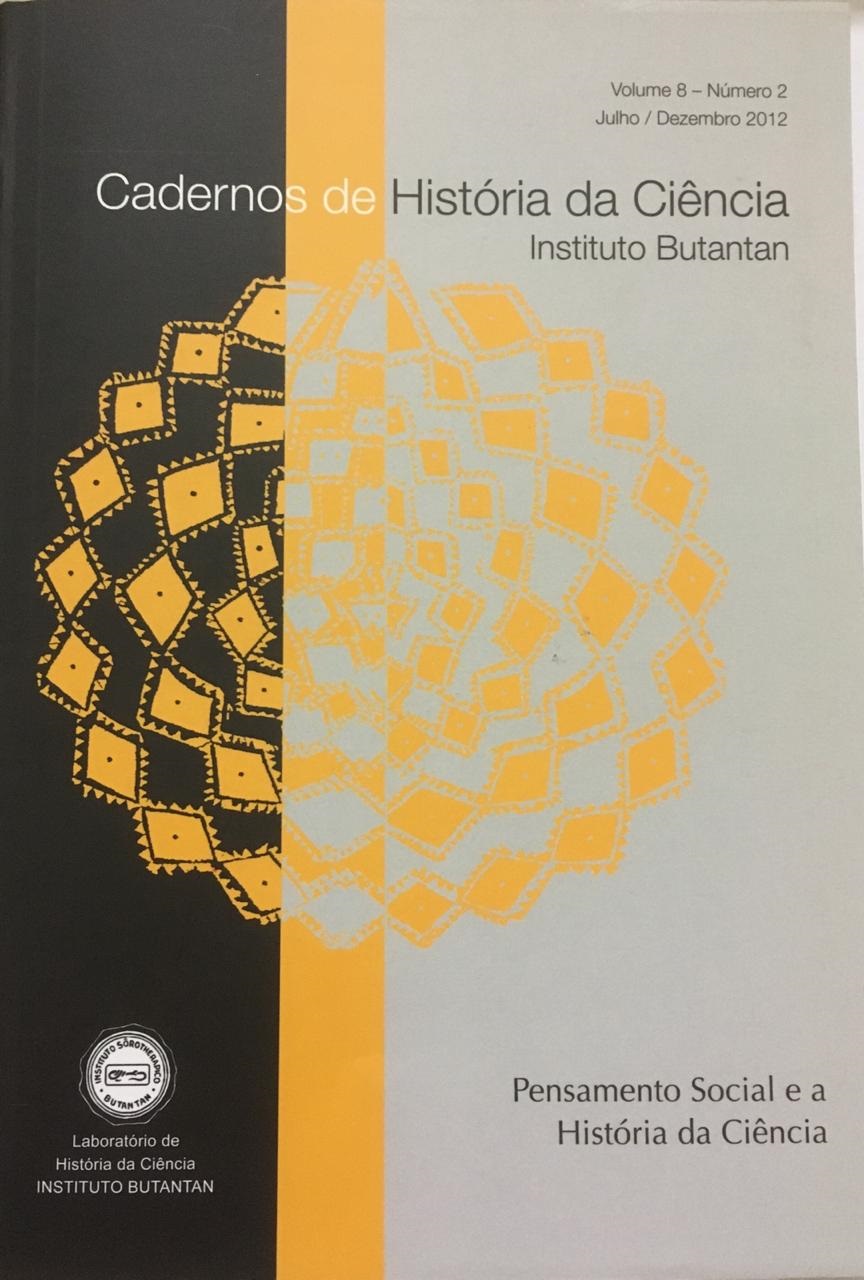Abstract
Ten years after the beginning of the activities of Butantan Institute, it was discovered the golden lancehead from the Queimada Grande Island. In 1911, several specimens of this species up until then unknown from science were received. Since then, researchers have back to the island, staying there for many days studding and collecting various specimens that were registered in the collection of the Herpetologic of Butantan Institute. The main objective of the first studies on the golden lancehead was to describe the new specie and to provide data on its natural history. However, recent studies have shown a population decline and the focus has changed to studies on the conservation of the species. Thus, aiming management and conservation recent studies has been concentrated in the areas of ecology, reproduction, behavior and evolution.
References
______. Contribuição para o conhecimento dos ophidios do Brasil. A. Parte II. Biologia da nova espécie, Lachesis insularis. Mem. Inst. Butantan. São Paulo, 1921b, n(I) v(II): 39-44.
______. Excursão a Ilha da Queimada Grande: notas sobre a biologia de uma Lachesis ali existente. Mem. Inst. Butantan. São Paulo, 1927, v(2): 49-57.
______. Contribuição ao conhecimento dos ophidios do Brasil. IV. Lista remissiva dos ophidios do Brasil. Mem. Inst. Butantan. São Paulo, 1929, v(4): 69-125.
Andrades DV, Marques OAV, Gavira RSB, Barbo FE, Zacariotti RL, Sazima I. Tail luring by the golden lancehead (Bothrops insularis), an island endemic snake from south-eastern Brazil. South Am J Herpetol. 2010, n(5) v(3): 175-180.
Bovo RP. Ecologia termal da jararaca-ilhoa, Bothrops insularis (Serpentes,Viperidae): um estudo em condições naturais. [Dissertação de Mestrado]. São José do Rio Preto (SP): Instituto de Biociências, Letras e Ciências Exatas, Universidade Estadual Paulista “Júlio de Mesquita Filho”; 2009.
______, Marques OAV, Andrades DV. Does gestation or feeding affect the bodytemperature of golden lancehead, Bothrops insularis (Squamata:Viperidae) under field conditions? Zoologia. 2010, n(27) v(6): 973-978.
______, ______, ______. When Basking Is Not an Option: Thermoregulation of a Viperid Snake Endemic to a Small Island in the South Atlantic of Brazil. Copeia. 2012, n(3): 408–418.
Campos JS, Melo-Filho LE. Observações biológicas sobre a Ilha da Queimada Grande. Folha Med. 1966, n(52): 343-366.
Dean W. A ferro e fogo: a história e a devastação da Mata Atlântica brasileira. São Paulo: Companhia das Letras. 1996.
Duarte MR, Puorto G, Franco FL. A biological survey of the pitviper Bothrops insularis Amaral (Serpentes, Viperidae): an endemic and threatened offshore island snake of southeastern Brazil. Stud Neotrop Fauna Environ. 1995, n(30): 1-13.
______. Microhabitat e relações térmicas da jararaca ilhoa, Bothrops insularis (Serpentes, Viperidae) [Dissertação de Mestrado]. Botucatu (SP): Instituto de Biociências da Universidade Estadual Paulista,1999.
______. Comunicação pessoal. São Paulo: Instituto Butantan, 2008. Guimarães MR, Bovo RP, Kasperoviczus KN, Marques OAV. Bothrops insularis (Golden Lancehead). Maximum length. Herpetological Review. 2010, n(41) v(1): 89.
Hoge AR. Um novo lagarto da Ilha da Queimada Grande. Mem. Inst. Butantan. São Paulo, 1946, n(19): 241-248.
______. Notas erpetológicas. Fauna erpetológica da Ilha da Queimada Grande. Mem. Inst. Butantan. São Paulo, 1950, n(22): 151-172.
______, Belluomini HE, Schreiber G, Penha AM. Sexual abnormalities in Bothrops insularis (Amaral) 1921 (Serpentes). Mem. Inst. Butantan. São Paulo, 1959, n(29): 17-88.
Huang M. The present state of Agkistrodon shedaoensis population. In: Zhao E (ed.), From Water Onto Land. Beijing: China Forestry Press, 1990: 271-272.
Kasperoviczus KN. Biologia reprodutiva da jararaca ilhoa (Serpentes: Viperidae) da Ilha da Queimada Grande. [Dissertação de Mestrado]. São Paulo: Instituto de Ciências Biomédicas, Universidade de São Paulo. 2009.
Macarrão A. Avifauna da ilha da Queimada Grande, SP: diversidade, estrutura trófica, sazonalidade. [Dissertação de Mestrado]. São José do Rio Preto (SP): Instituto de Biociências, Letras e Ciências Exatas da Universidade Estadual Paulista “Júlio de Mesquita Filho”, 2010.
Marques OAV, Martins M, Develey PF, Macarrão A, Sazima I. The golden lancehead Bothrops insularis (Serpentes: Viperidae) relies on two seasonallyplentiful bird species visiting its island habitat. J. Nat. hist. 2012, n(46) v(13-14): 885-895.
______, Kasperoviczus KN, Almeida-Santos SM. Reproductive ecology of the threatened pitviper Bothrops insularis from Queimada Grande Island, southeast, Brazil. J. Herpetol, in press. 2013, n(47) v(3): 393-399.
Martins M, Sawaya RJ, Marques OAV. A first estimate of the population size of the critically endangered lancehead, Bothrops insularis. South Am J Herpetol. 2008, n(3): 168-174.
Puorto G. Comunicação pessoal. São Paulo: Instituto Butantan, 2007. Queimada Grande: uma ilha de veneno. Novaciência. 1989, nov./dez.: 32-36.
Romano-Hoge A. Comunicação pessoal. São Paulo: Instituto Butantan, 2007.
Travaglia-Cardoso SR, Zelanis A, Furtado MFD. Sexual dimorphism in development and venom production of the insular threatened pit viper Bothrops insularis (Serpentes: Viperidae) of Queimada Grande Island, Brazil. Journal of Threatened Taxa. 2010, n(2): 1177-1184.
Vanzolini PE. Distribution and differentiation of animals along the coast and in continental islands of the state of S. Paulo, Brazil. I. Introduction to the area and problems. Pap Avulsos Zool. 1973, n(26): 281-294.
Zelanis A. Análise da variabilidade ontogenética do veneno de Bothrops insularis (Amaral, 1921) (Serpentes, Viperidae): implicações adaptativas aos itens alimentares [Dissertação de Mestrado]. São Paulo: Instituo de Biociências da Universidade de São Paulo, 2006.
_______, Travaglia-Cardoso SR, Furtado MFD. Ontogenetic changes in the venom of Bothrops insularis (Serpentes: Viperidae) and its biological implication. South Am J Herpetol. 2008, n(3): 43-50.
______, Ventura JS, Chudzinski-Tavassi AM, Furtado MFD. Variability in expression of Bothrops insularis snake venom proteases: an ontogenetic approach. Comp Biochem Physiol C. 2007, n(145): 601-609.
